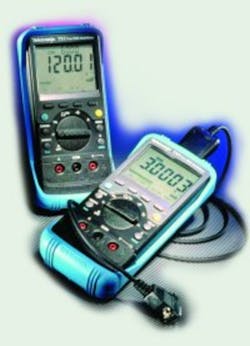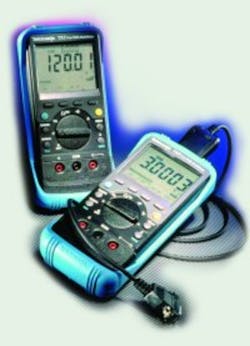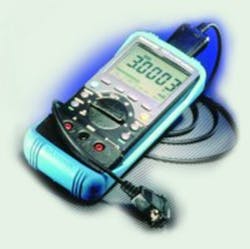Regardless of your job responsibilities, probably each of you has a hand-held digital multimeter (DMM) or can locate one very quickly. These portable, battery-operated devices have become a vital part of our lives as we investigate malfunctions in electronic equipment. Fortunately, the versatility of these instruments is making giant strides as manufacturers are providing the performance and operational features that you need to do your job.
A survey funded by Tektronix shows that almost 60% of the true-rms instruments are used by personnel who must walk to the equipment being serviced. The plant-based maintenance person has the luxury of reaching for an oscilloscope or a DMM and frequently chooses the former. The professional service person with a well-equipped van often has the same opportunity and selects the portable oscilloscope in many cases.
The real volume users, then, service a variety of low- to moderate-technology equipment on the fly and don’t need or want to lug the oscilloscope from place to place. For them, the hand-held DMM is easy to carry and use.
You can find the other 40% of these meters in the manufacturing area or the development laboratory where their small size and versatility make them useful as the diagnostic instrument of first resort.
Measurement Capabilities
Some DMMs have special inputs for checking logic elements. A special diode protection feature enables the instrument to apply a low voltage and reverse its polarity automatically.
Do you want your data displayed as a relationship to another value? The decibel (or decibels above 1 mW) ratio can be displayed alongside the data on one brand of meter. Some meters will compute and display a measurement as a percent of the specified reference or as the deviation from that reference. Other DMMs test and hold the minimum and maximum data values and possibly compute the long-term average as well. Or you can read the average of the past n measurements.
For display of data, several companies offer the choice of three digits (a count of zero to 1,000) to 3¾ digits (a count of zero to 4,000). For greater resolution, you have several options, including one meter with 6½ digits or a count of zero to 1,200,000, offering DC or AC voltage resolution as low as 0.1 mV.
Features
Just as we have seen the measurement capabilities expand, we can choose from an incredible selection of enhancements. One useful feature is simultaneous analog and digital display so you can visualize a condition quickly and then observe the measurement digitally. For the service person doing continuity checks, some DMMs offer an audible signal to indicate that the resistance is below a predetermined value.
And if you forget to turn a meter off, you’ll welcome the instrument with automatic battery-saving turnoff after 20 to 30 minutes of inactivity.
We never have enough hands for troubleshooting, so some instruments now give you a choice of automatic or manual range selection. Another useful feature is a data-holding capability where each measurement is displayed even after the test leads are removed from a circuit.
Other capabilities include simultaneous display of frequency and AC voltage, glitch capture, harmonic index display, selectable meter impedance to avoid overload of sensitive circuits, math function calculation, power disturbance detection, and power-factor measurement. Other features of importance in many troubleshooting applications are large bright displays, dustproof cases, shock-resistant packaging, long battery life, and a carrying holster.
Some functions of the hand-held DMM are useful for only specific applications. For example, true-rms readings are essential for some users but of no value to those involved solely in making DC measurements. Also, autoranging is preferred for most requirements but not needed for repetitive measurements.
Concerning the use of a DMM for current measurement, Michael Engbretson, product manager for hand-held DMMs and oscilloscopes at Tektronix, pointed out, “A feature that makes a DMM easy to use is a single current input jack corresponding to a single current range selector. You must break the circuit to make a current measurement, and you certainly don’t want to power down and select different input jacks each time you guess wrong.”
Operator safety is yet another important consideration in evaluating a hand-held DMM. Two well-known organizations have safety codes for these electronic instruments. The European Union has directives governing products to be sold in Europe. The best known is the Low-Voltage Directive which sets product safety standards and designates the CE Marking as assurance that a product has met the standards. All the DMMs in the comparison chart that accompanies this article have the CE Marking.
The International Electrotechnical Commission (IEC) also has safety standards that apply to hand-held DMMs. Many instruments are certified to the IEC 1010-1 standard in addition to the CE Marking.
Summary of Capabilities
Many companies offering hand-held DMMs incorporate measurement capabilities and features that may be especially important to you. Probably you will find the combination of characteristics that you need in one or more of the DMMs in the comparison chart. If so, happy measuring. If not, tell the manufacturer. Possibly your comments will start some wheels turning, and your suggested improvement could be included in the next new DMM.
|
For more information on DMMs, |
Published by EE-Evaluation Engineering
All contents © 2000 Nelson Publishing Inc.
No reprint, distribution, or reuse in any medium is permitted
without the express written consent of the publisher.
February 2000


